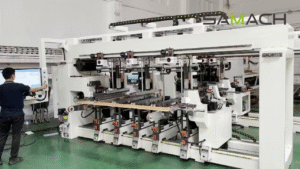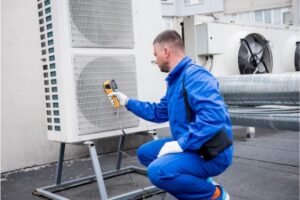
Rust is more than just a nuisance—it’s a destructive force that deteriorates metal surfaces, weakens structural integrity, and ruins the appearance of valuable equipment. Traditional methods like sanding, grinding, and chemical solutions have long been used to combat corrosion. But in recent years, an innovative technology has been making waves in the world of industrial maintenance: the laser rust cleaner.
This advanced tool offers a futuristic solution to an age-old problem. But the burning question remains: Can a laser rust cleaner truly eliminate years of rust without damaging the underlying metal? To answer this, let’s take a deep dive into how it works, where it can be used, and why it’s becoming a preferred option across various industries.
Understanding How a Laser Rust Cleaner Works
A laser rust cleaner operates on the principle of laser ablation. This process involves firing a high-intensity laser beam at a rusted surface. The energy from the laser heats and vaporizes the layer of rust, carbon, or oxide without affecting the material underneath. Unlike abrasive methods that physically grind away layers, laser cleaning is non-contact and highly selective.
Because the laser can be finely tuned, it can distinguish between corrosion and the base metal. As the laser passes over the surface, it removes contaminants without cutting or heating the metal below to dangerous levels. This makes it a remarkably precise cleaning tool that avoids warping or scarring the metal—a common problem with older techniques.
Applications That Go Beyond Expectations
The laser rust cleaner isn’t just for industrial giants; it has found its place in a wide array of sectors. From restoring classic cars to maintaining military equipment, this tool is helping professionals achieve results that were once nearly impossible.
-
Automotive Restoration: Car enthusiasts and restoration experts use laser rust cleaners to delicately remove corrosion from vehicle frames and parts without damaging vintage components.
-
Shipyards and Marine Industry: Saltwater corrosion is a serious issue in marine environments. Laser cleaning helps maintain ships, submarines, and offshore equipment efficiently.
-
Aerospace Maintenance: Precision is paramount in aerospace, and the ability of laser cleaners to target only rust without affecting nearby parts makes them ideal in this high-stakes field.
-
Public Infrastructure: Bridges, pipelines, and railroads often require large-scale rust removal. Laser cleaning offers a cleaner, safer way to conduct ongoing maintenance.
-
Art and Heritage Conservation: Museums and conservators are turning to laser rust cleaners to remove corrosion from historical artifacts with minimal risk to their integrity.
Why It’s Gaining Popularity
The popularity of the laser rust cleaner is growing fast, not because it’s a shiny new toy, but because it meets real-world demands in ways traditional tools cannot. Here are some compelling reasons behind the shift:
-
Non-Destructive Cleaning: Instead of physically grinding the surface, the laser gently lifts rust away, leaving the original texture and dimensions intact.
-
Eco-Friendly Process: There are no harsh chemicals or secondary waste involved. This makes it a greener solution compared to acid baths or sandblasting.
-
Precision and Control: Operators can adjust the laser’s intensity and focus to treat different materials and levels of corrosion, ensuring the right touch every time.
-
Portability and Ease of Use: Handheld laser rust cleaners can be taken to worksites, and modern systems are designed for intuitive operation.
These attributes allow professionals to work faster, cleaner, and with greater confidence—especially in situations where surface integrity matters most.
Is it Safe for All Types of Metal?
One of the most common concerns with any cleaning method is whether it can safely be used on various metals. The good news is that a laser rust cleaner can be applied to a wide range of materials including steel, aluminum, copper, and iron. The laser can be calibrated to match the specific reflectivity and thermal tolerance of each metal.
However, successful operation depends on proper settings and operator expertise. While the tool is forgiving compared to chemical methods, improper use can lead to suboptimal results or, in rare cases, minor surface marks. Training and hands-on practice are essential to ensure the cleaner is used to its full potential.
Is It Worth the Investment?
Purchasing or renting a laser rust cleaner may involve a higher initial cost compared to sandblasting or chemicals. But this is where many people make the mistake of focusing solely on upfront expenses rather than long-term value.
Consider the costs of:
-
Continuous purchase of chemical solvents
-
Replacement of damaged parts due to aggressive cleaning
-
Labor and time involved in setting up and cleaning up traditional rust removal methods
-
Safety gear and environmental compliance when using toxic materials
When viewed through a long-term lens, laser rust cleaning proves to be a cost-effective, low-maintenance, and safer investment. It offers a professional-grade solution that doesn’t just clean—but transforms the way we maintain and restore metal surfaces.
Choosing the Right Laser Rust Cleaner
If you’re in the market for a laser rust cleaner, it’s crucial to select the right system for your specific needs. Factors to consider include:
-
Wattage and Power Output: Higher wattage means deeper cleaning for tougher rust, but may be overkill for delicate surfaces.
-
Type of Laser: Fiber lasers are the most common for rust removal. They offer stable performance and long service life.
-
Portability vs. Industrial Systems: Handheld units are ideal for workshops and fieldwork, while larger machines suit heavy-duty industrial applications.
-
Ease of Use: Look for systems with intuitive controls, good user interfaces, and available customer support or training.
Researching brands, reading reviews, and testing demos when possible can help ensure you invest in the right machine for the job.
Real-World Testimonials
Around the globe, professionals are making the switch to laser technology and never looking back. Here’s what some users have to say:
“We’ve cut our cleaning time in half using a laser rust cleaner. Our staff prefers it over any other method.”
— Maintenance Manager, Railworks Corp
“The precision is unmatched. We were able to restore delicate brass fittings without a single scratch.”
— Art Conservator, Heritage Trust
“No more chemical fumes or dangerous waste. The laser cleaner is safer for our team and the environment.”
— Operations Director, Marine Coatings Inc.
Final Thoughts
The question of whether a laser rust cleaner can truly remove years of corrosion without damaging the metal beneath isn’t just theoretical—it’s been answered time and again in real-world applications. From its precise, non-destructive cleaning capabilities to its environmentally friendly operation, the laser rust cleaner is redefining rust removal across industries.
This isn’t just another tool—it’s a smarter, cleaner, and more responsible way to preserve and restore metal. Whether you’re working on automotive parts, antique artifacts, or industrial machinery, switching to laser cleaning can transform your approach and elevate the quality of your work.
If you’re ready to say goodbye to outdated, messy rust removal techniques, it might be time to explore the future of surface cleaning—powered by the precision of laser.



